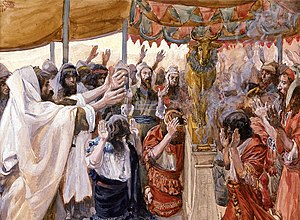
Back Ki Tissa German Ki Tissa French פרשת כי תשא HE Ki Tissa ID Ki Tisa Italian Ki Tissa JV Ки Тиса Russian פרשת כי תשא YI

Ki Tisa, Ki Tissa, Ki Thissa, or Ki Sisa (כִּי תִשָּׂא—Hebrew for "when you take," the sixth and seventh words, and first distinctive words in the parashah) is the 21st weekly Torah portion (parashah) in the annual Jewish cycle of Torah reading and the ninth in the Book of Exodus. The parashah tells of building the Tabernacle, the incident of the Golden calf, the request of Moses for God to reveal God's Attributes, and how Moses became radiant.
The parashah constitutes Exodus 30:11–34:35. The parashah is the longest of the weekly Torah portions in the book of Exodus (although not the longest in the Torah, which is Naso), and is made up of 7,424 Hebrew letters, 2,002 Hebrew words, 139 verses, and 245 lines in a Torah scroll (Sefer Torah).[1]
Jews read it on the 21st Sabbath after Simchat Torah, in the Hebrew month of Adar, corresponding to February or March in the secular calendar.[2] Jews also read the first part of the parashah, Exodus 30:11–16, regarding the half-shekel head tax, as the maftir Torah reading on the special Sabbath Shabbat Shekalim (as on March 1, 2014, when Exodus 30:11–16 was read along with parashah Pekudei). Jews also read parts of the parashah addressing the intercession of Moses and God's mercy, Exodus 32:11–14 and 34:1–10, as the Torah readings on the fast days of the Tenth of Tevet, the Fast of Esther, the Seventeenth of Tammuz, and the Fast of Gedaliah, and for the afternoon (Mincha) prayer service on Tisha B'Av. Jews read another part of the parashah, Exodus 34:1–26, which addresses the Three Pilgrim Festivals (Shalosh Regalim), as the initial Torah reading on the third intermediate day (Chol HaMoed) of Passover. And Jews read a larger selection from the same part of the parashah, Exodus 33:12–34:26, as the initial Torah reading on a Sabbath that falls on one of the intermediate days of Passover or Sukkot.
- ^ Akhlah, "Torah Stats for Shemoth."
- ^ "Parashat Ki Tisa". Hebcal. Retrieved February 15, 2018.